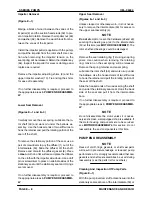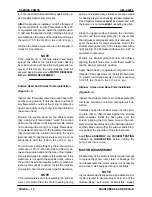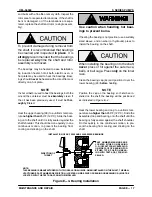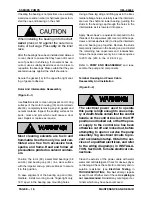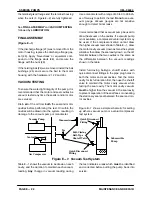
S SERIES PUMPS
OM-06099
MAINTENANCE AND REPAIR
PAGE E - 22
the terminal gland flange and the terminal housing
when the nuts (5, Figure E-2) are fully tightened.
See
FINAL ASSEMBLY
and
VACUUM TESTING
followed by
LUBRICATION
.
FINAL ASSEMBLY
(Figure E-1)
If the discharge flange (27) was removed from the
motor housing, replace the discharge flange gas
ket (26). Apply `Never‐Seez' or equivalent com
pound on the flange studs (28), and secure the
flange with the nuts (29).
If the hoisting bail (24) was removed, install the bail
bushings (25) and secure the bail to the motor
housing with the hardware (21, 22 and 23).
VACUUM TESTING
To ensure the water‐tight integrity of the pump, it is
recommended that the motor and seal cavities be
vacuum tested any time the seal(s) and/or motor
are serviced.
Drain
all
of the oil from
both
the seal and motor
cavities before performing the test. Oil within the
cavities will be drawn into the system, resulting in
damage to the vacuum pump or manometer.
Use a manometer with a range of 30 to 0 to 30 inch
es of mercury to perform the test.
Do not
use a vac
uum gauge. Vacuum gauges are not sensitive
enough to detect minor leaks.
It is recommended that a vacuum pump be used to
draw the vacuum on the cavities. If a vacuum pump
is not available, a compressor/venturi system may
be used. If the compressor/venturi cannot draw
the higher vacuum level shown in Table E-1, draw
the motor cavity vacuum down as far as the system
will allow, then draw the seal cavity down so the dif
ferential between the two cavities is the same as
the differential between the vacuum readings
shown in the table.
Install full‐closing ball‐type shutoff valves with
quick‐disconnect fittings in the pipe plug holes in
both the motor and seal cavities. Test the motor
cavity for its full duration first, then use the shutoff
valve to maintain the motor cavity vacuum while
testing the seal cavity. The motor cavity vacuum
must
be higher than the vacuum in the seal cavity
to prevent separation of the seal faces or unseating
the stationary seal seat between the seal and mo
tor cavities.
Figure E-7 shows a simple schematic for setting
up either a vacuum pump or a venturi/compressor
test system.
ÎÎÎ
ÎÎÎ
Tee
Manometer
Vacuum Pump
Submersible
Pump
Full-Closing
Ball-Type
Shutoff Valve
Quick Disconnect
Fitting
Quick Disconnect
Fitting
Air Compressor
Venturi
Figure E-7. Vacuum Test System
Table E-1 shows the vacuum to be drawn on each
cavity, and the duration to maintain each vacuum
reading.
Any
change in vacuum reading during
the test indicates a leak which
must
be identified
and corrected before putting the pump back into
service.

